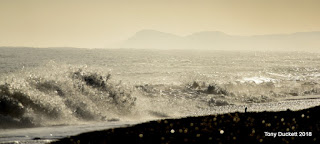7 days birding in Norfolk at Prime Time
Well as the heading states it was prime time for migrants in Norfolk. I arrived on Wednesday afternoon Mark (oldest friend) the next morning, my brother could only manage the Friday and finally Clive arrived on Saturday and went home on Monday evening. Mark and I stayed until mid day on Wednesday. As we all know birds particularly passerines need a helping hand if they are to cross the North Sea in the form of an easterly wind. Well we had westerlies, swinging around to north westerlies and back to south westerlies but not once did it swing around to an easterly sector help us out. This meant that Norfolk was virtually passerine free with the odd exception a Barred Warbler at Burnham Overy Dunes and the odd Wheatear (I saw 3), Whinchats were reported at several sites but in 1's and 2's. There were no winter thrushes, larks and very few Meadow Pipits, I did pick out several hugging the troughs as the came across the North Sea.
This first section seems to paint a horrible picture of Norfolk when really nothing could be further from the truth. There may have been virtually no passerines, low numbers of wader but if you like waterfowl and the spectacle of 100's of Pink-footed Geese, Teal, Wigeon, Pintail and Common Scoter crossing the North Sea, ducks at low level and the Pinkies high above the deadly blades of the windfarms that litter the east coast. There were lesser numbers of Red-throated Divers, the odd Black-throated, Great Skuas, Arctic Skuas and the amazing spectacle of 200+ Mediterranean Gulls of every plumage you could imagine.
Below is a pictorial from our time away

The wader in the first 5 photos was/is one that I haven't seen in my life before, well not that I can recall, it was about the size of the smallest reeve. It certainly isn't a Greenshank, even with mud on the bill the shape should remain the same or almost the same. At no time did it have the jizz of a Greenshank.which was one of the species some of the answers that came back to me suggested it was.There was one species mentioned that hadn't entered my head as being answer Grey-tailed Tattler. Looking at images especially distant photos of that species, my bird does have many similarities in common with Grey-tailed Tattler. What's your opinion
Little Egret
Stonechat
Well as the heading states it was prime time for migrants in Norfolk. I arrived on Wednesday afternoon Mark (oldest friend) the next morning, my brother could only manage the Friday and finally Clive arrived on Saturday and went home on Monday evening. Mark and I stayed until mid day on Wednesday. As we all know birds particularly passerines need a helping hand if they are to cross the North Sea in the form of an easterly wind. Well we had westerlies, swinging around to north westerlies and back to south westerlies but not once did it swing around to an easterly sector help us out. This meant that Norfolk was virtually passerine free with the odd exception a Barred Warbler at Burnham Overy Dunes and the odd Wheatear (I saw 3), Whinchats were reported at several sites but in 1's and 2's. There were no winter thrushes, larks and very few Meadow Pipits, I did pick out several hugging the troughs as the came across the North Sea.
This first section seems to paint a horrible picture of Norfolk when really nothing could be further from the truth. There may have been virtually no passerines, low numbers of wader but if you like waterfowl and the spectacle of 100's of Pink-footed Geese, Teal, Wigeon, Pintail and Common Scoter crossing the North Sea, ducks at low level and the Pinkies high above the deadly blades of the windfarms that litter the east coast. There were lesser numbers of Red-throated Divers, the odd Black-throated, Great Skuas, Arctic Skuas and the amazing spectacle of 200+ Mediterranean Gulls of every plumage you could imagine.
Below is a pictorial from our time away

The wader in the first 5 photos was/is one that I haven't seen in my life before, well not that I can recall, it was about the size of the smallest reeve. It certainly isn't a Greenshank, even with mud on the bill the shape should remain the same or almost the same. At no time did it have the jizz of a Greenshank.which was one of the species some of the answers that came back to me suggested it was.There was one species mentioned that hadn't entered my head as being answer Grey-tailed Tattler. Looking at images especially distant photos of that species, my bird does have many similarities in common with Grey-tailed Tattler. What's your opinion
Pectoral Sandpiper
Our first 11 Pink-footed Geese coming into land at Babcock Hide on the Cley NWT Reserve.
spending the next hour preening and snoozing. It was good to see that a third were youngsters.
Pink-footed Geese over the North Sea
Red-throated Diver
Great Skua over the windfarm
Arctic Skua
Manx Shearwater
Gannets are a joy to watch as they glide over the sea
The coast at viewed from Cley Beach
Common Scoter
Common Teal
Wigeon and Pintail
Shoveler
Pintail
Gadwall
Gadwall
Garganey female
An impressive number of Mediterranean Gulls were in the fields near the Happisburgh coastal
watch point
Green Sandpiper
Curlew Sandpiper
Ruff
Black-tailed Godwit even with a muddy bill the shape is still visible
Spotted Redshanks
Little Egret
This was a very small male Peregrine Falcon
Marsh Harrier
Sparrowhawk possibly carrying the remains of a Green Sandpiper
Bearded Tit
Reed Warbler
Northern Wheatear
Meadow Pipit
Stonechat


















































































Comments